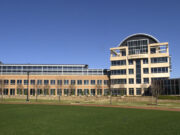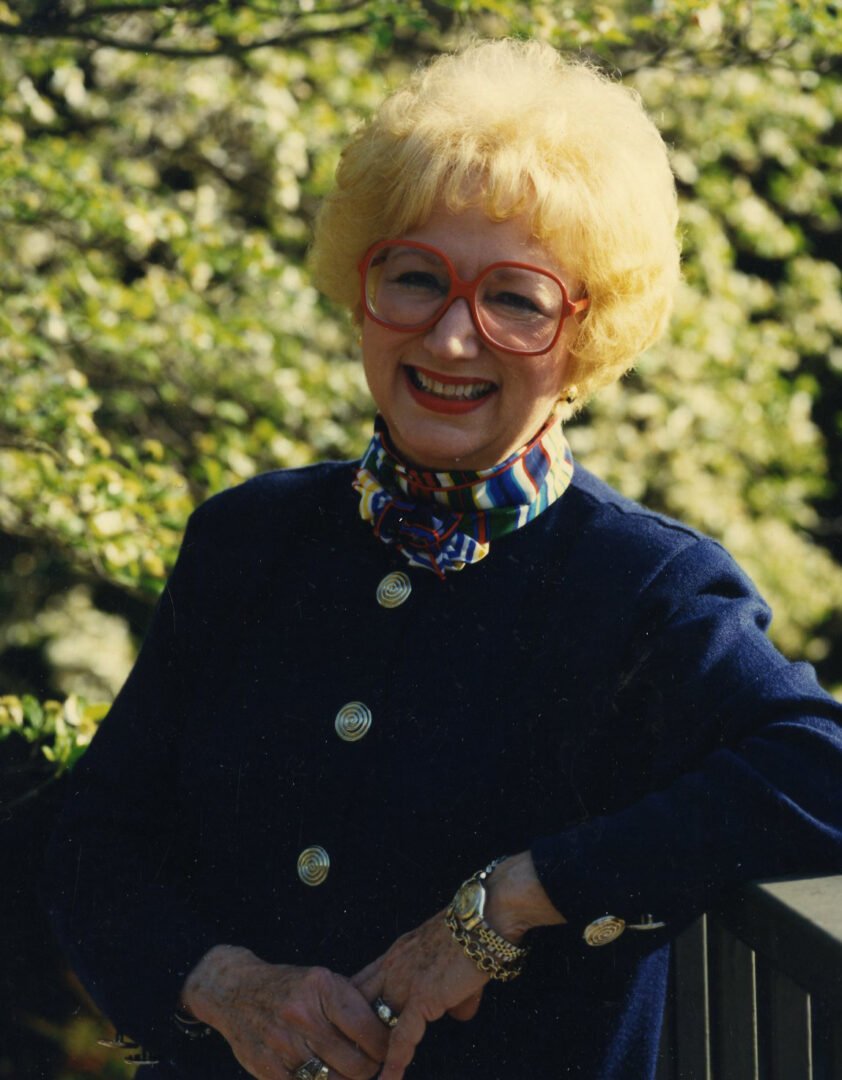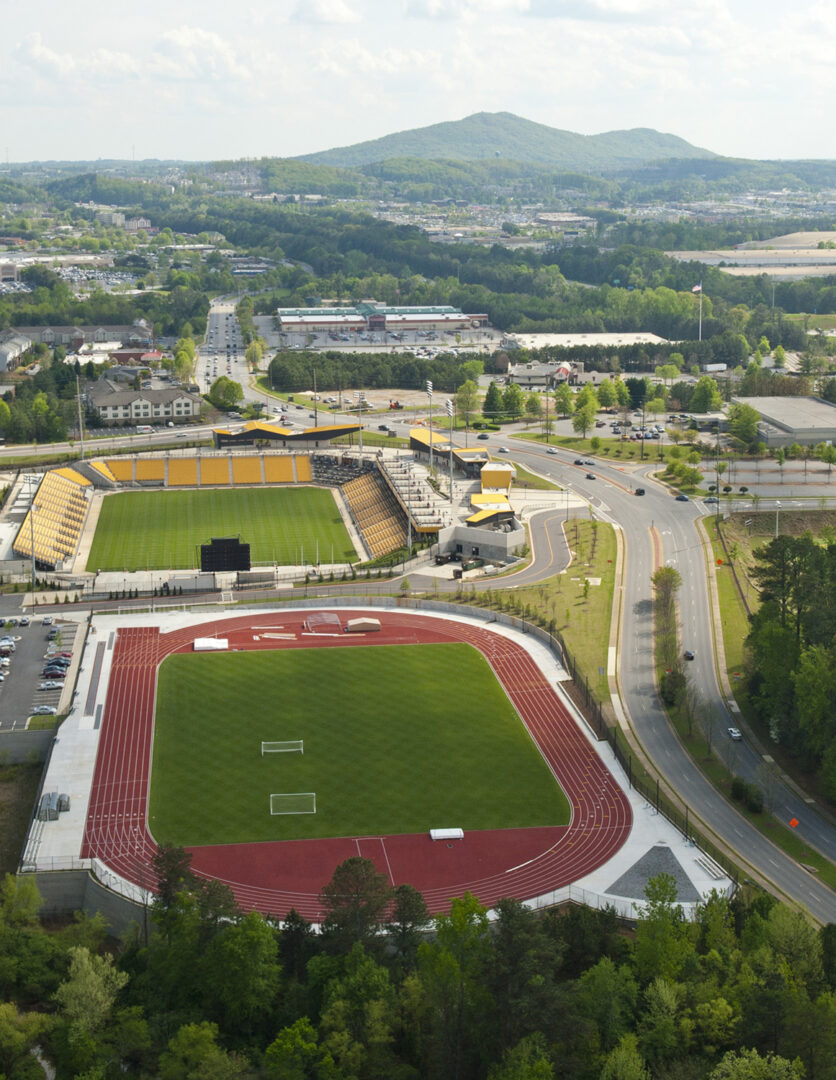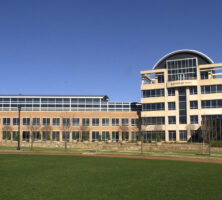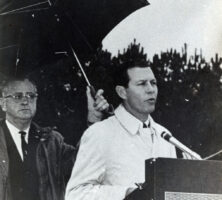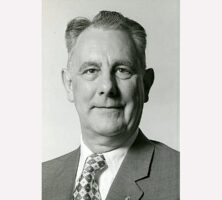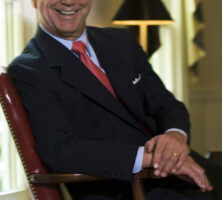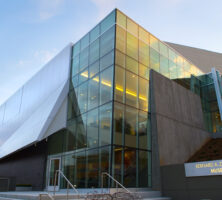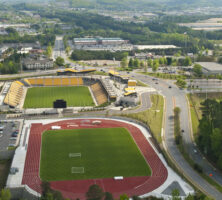Kennesaw State University (KSU), a unit of the University System of Georgia (USG), is the second largest university in the state, with a fall 2022 enrollment of roughly 43,000.
In January 2015 Kennesaw merged with Southern Polytechnic State University (SPSU), bringing together the schools’ campuses and students under KSU’s name. The main campus is located near Kennesaw, along I-75 in Cobb County, and the former SPSU campus, ten miles south, serves as a satellite campus. KSU draws most of its students from metropolitan Atlanta but also attracts students from around the state and the nation. During Fall 2022 the university also enrolled students from 108 countries. Since 2018 it has been designated an R2 research institution, demonstrating the increasing importance of research at the university.
Founding
KSU was chartered by the Board of Regents on October 9, 1963, during one of the most dramatic periods of college expansion in Georgia’s history. Home to a large aircraft industry and two air bases, Cobb County exemplified the New South that emerged in the aftermath of World War II (1941-45). Between 1940 and 1960, as Cobb tripled in size, the county became home to an affluent, well-educated population determined to improve educational opportunities for Georgia’s youth.
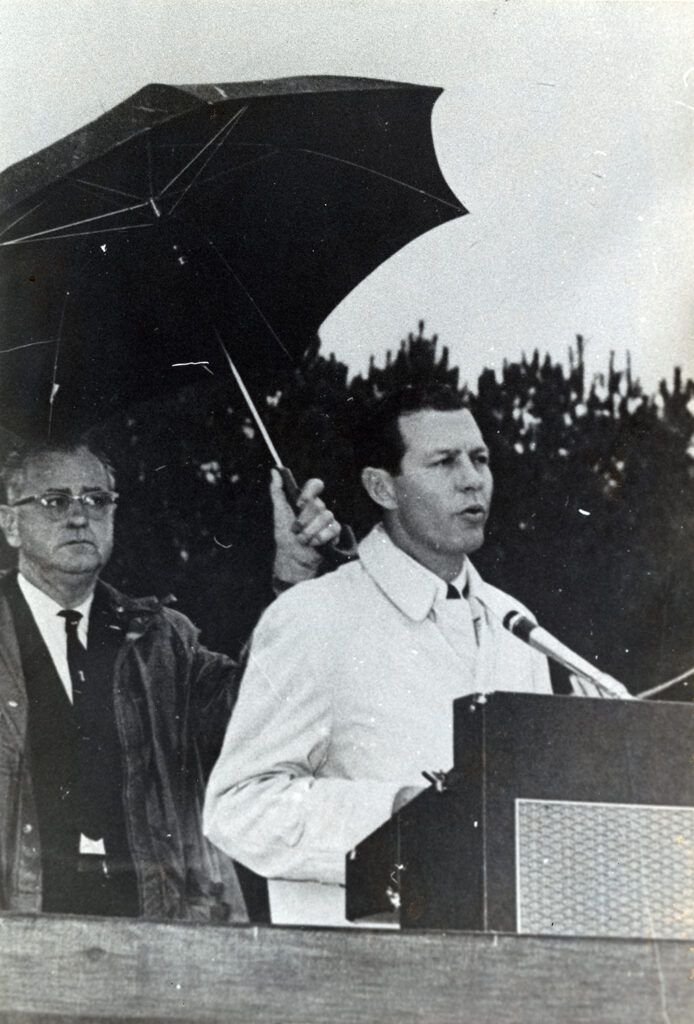
After World War II the University of Georgia established off-campus centers in a number of towns around the state. The Marietta Center, for example, operated in Cobb County from 1951 to 1966. By the early 1960s, as the first of the baby boom generation reached college age, educators and politicians felt pressure to construct more classrooms, and people around the state made clear their preference for autonomous two-year community campuses. In 1962 Carl Sanders won the governorship with a pledge to place a college within commuting distance of practically every Georgian. Between 1961 and 1968 the Board of Regents chartered nine new junior colleges, three of them (in Albany, Dalton, and Kennesaw) established in 1963 alone.
During his 1962 campaign Sanders had promised a new college to neighboring Bartow County. Leaders in Cobb realized that both counties were not likely to win a new institution, so they approached the regents with the most generous offer any community had made up to that time. The city of Marietta and the Cobb County Board of Education agreed to sell $2.35 million in bonds to pay for the land, original buildings, roads, utilities, and landscaping needed to construct a new college. Eventually, the total costs reached almost $3.25 million. Fortunately, a federal grant more than made up the difference, allowing a new public college to be built in Georgia for the first time without the expenditure of state dollars.
In part to appease disappointed Bartow residents, the Board of Regents built the campus in north Cobb, about halfway between Marietta and Cartersville, the seat of Bartow County. The charter president, Horace W. Sturgis, took office on July 1, 1965. Because of labor troubles the new campus was not completed until January 1967. Nonetheless, courses at Kennesaw Junior College began in September 1966, in classrooms provided by the Southern Technical Institute (later Southern Polytechnic State University) in Marietta. Some 1,014 students enrolled for the first fall quarter.
Senior College Status
President Sturgis recalled that the initial question he received at his first meeting with local civic leaders was “When are we going to be a senior college?” From the beginning the college recruited faculty with four-year status in mind. In the early 1970s delegations of civic leaders made frequent visits to the Board of Regents to argue the case for conversion. In the 1974 gubernatorial election, local power brokers backed George Busbee in exchange for a promise from the future governor to help Kennesaw gain four-year status. In 1975 Marietta state representative Joe Mack Wilson managed to place $250,000 in the regents’ budget for Kennesaw’s conversion. When the board failed to use the money that year, Wilson succeeded in placing $250,000 in the next year’s budget. Supporting him in these efforts were a fellow Marietta legislator, Al Burruss, and the Appropriations Committee chair Joe Frank Harris of Cartersville, a member of the Kennesaw Junior College Foundation.
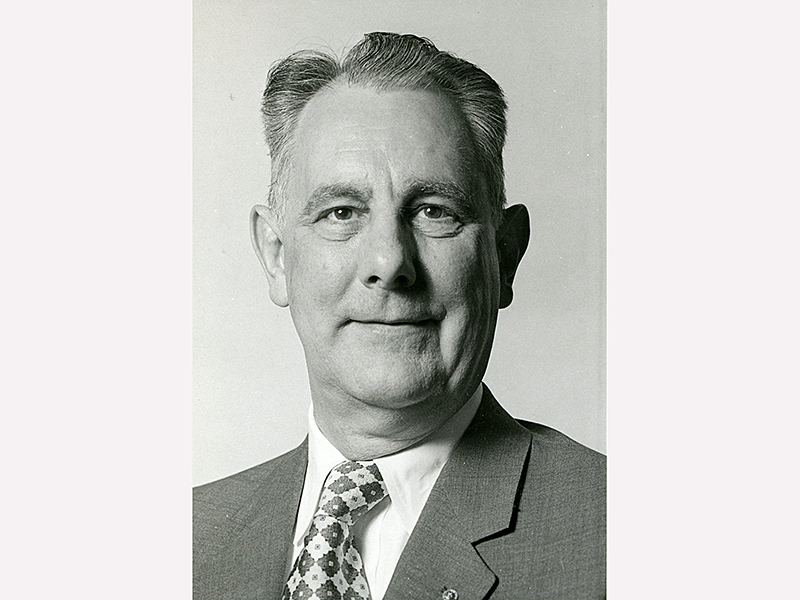
Opponents presented two strong arguments against Kennesaw’s elevation to the senior-college ranks. USG chancellor George Simpson sought to avoid a duplication of programs by using the junior colleges on each side of Atlanta as feeder institutions for Georgia State University. He also argued that the creation of a four-year school in predominantly white Cobb County would delay the university system’s efforts to meet a federal desegregation order.
On the other hand, by the 1970s Cobb County was the third largest county in Georgia, and the population was growing by more than 10,000 people a year. Most students at Kennesaw also held jobs; many were over the traditional college age and were married. The state had failed to place a public four-year college anywhere in northwest Georgia. The typical student found the trek into Atlanta to attend class an inconvenience and wanted a campus closer to home or work. With the support of several Busbee-appointed regents, Kennesaw advocates won their case, persuading the board on April 14, 1976, to turn the school into a four-year college. Under the plan the first upper-level classes were scheduled for fall quarter 1978 at the newly named Kennesaw College.
The Siegel Era
In 1980 Kennesaw graduated its first four-year class. Shortly afterward Sturgis announced his retirement. After a nationwide search, the regents in 1981 chose as the school’s new president Betty L. Siegel, the first woman to head an institution in the USG. She remained in the post until 2006, making her one of the longest-serving woman presidents in the nation. In her early years the institution embarked on a period of remarkable growth, jumping from fewer than 4,000 students in 1980 to more than 10,000 by 1990. Siegel persuaded the regents to initiate master’s level classes, beginning in 1985 with programs in business and elementary education. In 1988 the school’s name was changed to Kennesaw State College.
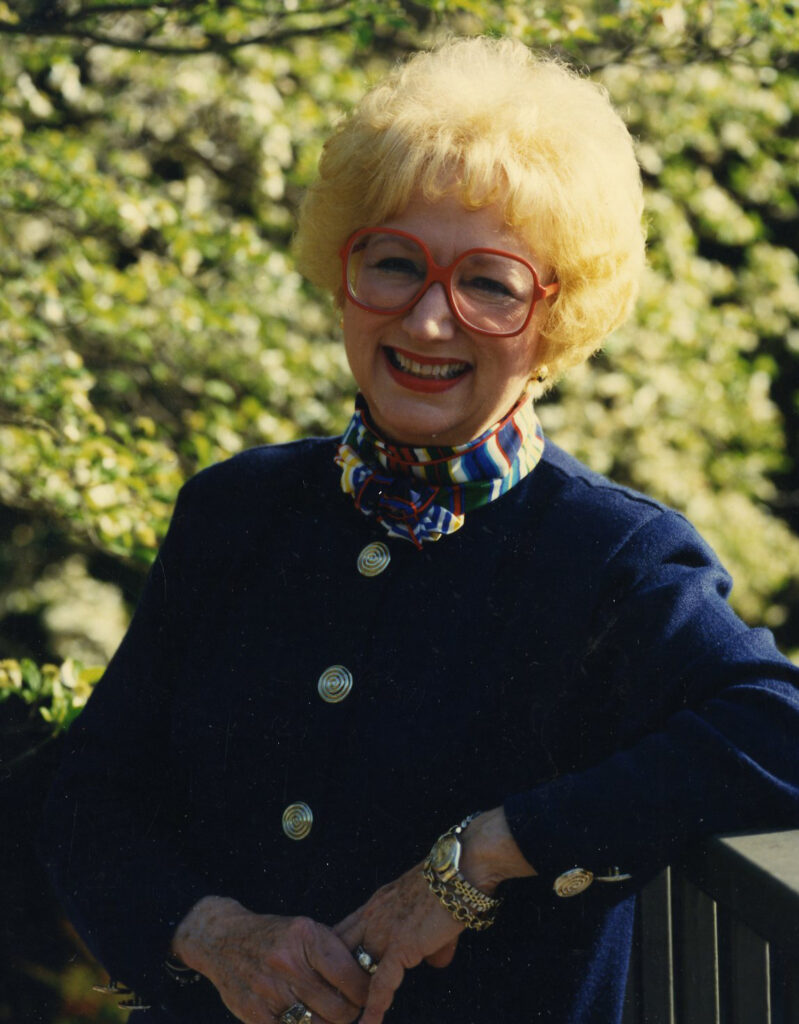
Siegel often remarked that she had served as president of at least three different colleges during her tenure at Kennesaw. The early 1980s were a time of growth in enrollment and in the number of programs designed to serve student and community needs. The late 1980s and early 1990s were a period of increased selectivity and specialization, when the campus began gaining recognition for such things as its first applied research center, the A. L. Burruss Institute of Public Service, established in 1988. The following year Kennesaw appeared for the first time in U.S. News and World Report’s list of the country’s “top up-and-coming regional colleges and universities.”
The second half of the decade was a time of increased distinction and significance for the school. Student enrollment continued to expand, reaching more than 15,000 by 2002. In 1996 Kennesaw achieved university status. That same year Success magazine listed KSU’s Coles College of Business in the nation’s top twenty-five schools for entrepreneurship. Also in 1996 the men’s baseball and women’s softball teams won National Collegiate Athletic Association (NCAA) Division II national championships, marking only the second time in NCAA history that one school won both titles in the same year.
Gingrich Controversy
Despite such success stories, Kennesaw saw its reputation tarnished in the 1990s, when questionable administrative decisions drew unwelcome attention. The most serious controversy centered on the offering of the “Renewing American Civilization” course taught in fall 1993 by Newt Gingrich, the Republican congressman whose district included the Kennesaw campus. The holder of a Ph.D. in history, Gingrich was qualified to teach the class. But the college’s impartiality came into question when the former executive director of GOPAC, a Gingrich-headed Republican political action committee, became the course project director and began sending out partisan requests for funding to wealthy GOPAC contributors. The Kennesaw State Foundation (later the KSU Foundation), a tax-exempt fund-raising group, was caught in the middle and served as a pass-through agency for almost $300,000, used to televise the course across the nation.
Although the class was stimulating, provocative, and popular with students, it made some people wonder whether the college had been seduced into supporting a partisan political crusade. After Gingrich became Speaker of the U.S. House of Representatives in 1995, the Ethics Committee launched an investigation that focused in part on the Kennesaw course. Ultimately, the committee found no evidence of wrongdoing but forced the Speaker to pay a fine because of conflicting statements filed by his attorneys. Meanwhile, the Kennesaw State Foundation became the subject of an Internal Revenue Service investigation that threatened to jeopardize its tax-exempt status. The probe continued until Gingrich’s resignation from Congress in 1998. By the time the foundation was exonerated, it had paid close to $400,000 in legal fees.
Growth in the New Century
During the Gingrich controversy the foundation was limited in its effectiveness, but by the turn of the century it began to play a central role in campus growth. The Board of Regents also played a role, providing state funding for new business, science, and visual arts buildings; a much enlarged Carmichael Student Center; and Kennesaw Hall, home of the Bagwell College of Education and the central administrative offices. The Siegel administration was frustrated, however, by its inability to persuade the regents to support residence halls, parking decks, and other campus needs. In 1999 the KSU Foundation took the first step toward providing a new funding model for facility improvements by leasing (and later purchasing) an outlet mall on the east side of I-75, which ultimately became the new home for Continuing Education, the Museum of History and Holocaust Education, and various campus institutes and centers.
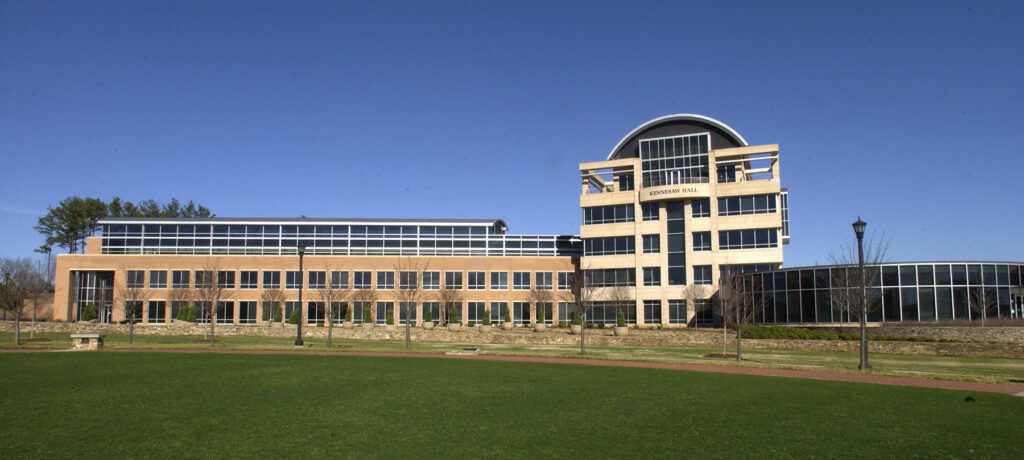
In fall 2002 Kennesaw opened its first parking decks and residence halls, neither requiring state funding. The opening of the residence halls transformed a campus culture that had long revolved around the needs of commuter students, and student demographics began changing dramatically. By 2013 some 3,500 students lived on campus, and several thousand more resided in nearby apartments. Under the leadership of chairman Michael J. Coles, the KSU Foundation built, owned, and operated the university’s new facilities through a ground lease authorized by the Board of Regents. Similar partnerships supported a host of projects over the next decade, including the Clendenin Computer Science Building, the Bailey Performance Center, a nationally recognized student culinary center, more parking decks and residence halls, additional office space, and an eighty-eight-acre sports and recreation complex.
During fall 2005—the last fall semester of the Siegel era—KSU’s enrollment reached 18,556, some 6,000 students above what it had been just a decade earlier. Siegel’s last decade as president was perhaps the happiest and most successful of her twenty-five-year tenure. A variety of initiatives came to fruition, the athletic program won NCAA Division II national championships in women’s soccer (2003) and men’s basketball (2004), and KSU began a transition in 2005 to NCAA Division I as a member of the Atlantic Sun Conference. In May 2006 the Board of Regents approved KSU’s first doctorate, an Ed.D. in Leadership for Learning.
The Papp Era
Daniel S. Papp assumed the presidency of KSU in July 2006. He had lived in Cobb County since 1973, when he joined the faculty of Georgia Tech as a young professor, and since 2000 he had served as the USG’s senior vice chancellor for academics and fiscal affairs. Under his leadership, the number of new construction projects increased, and KSU continued to expand its doctoral degree programs; the university’s first Ph.D. graduate earned her degree in May 2013.
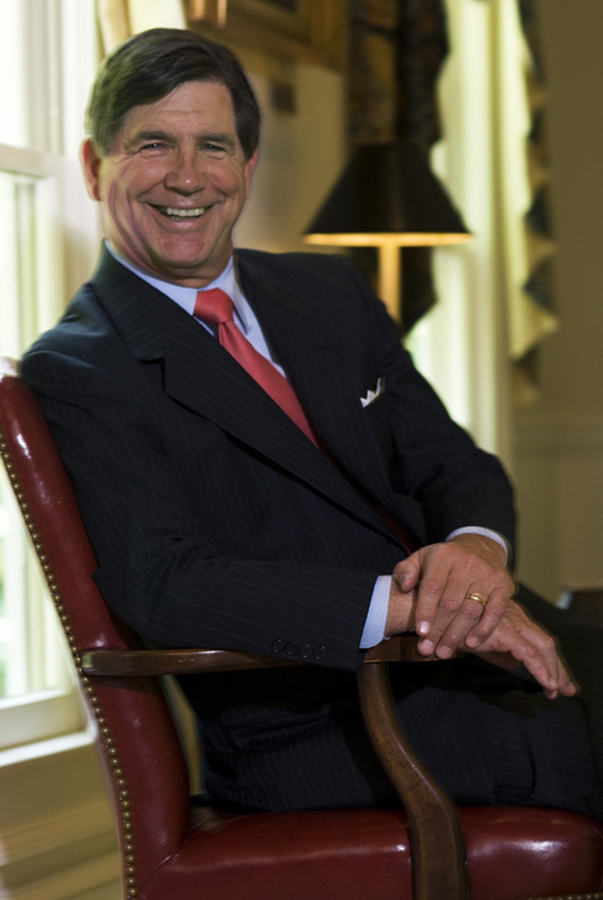
General retention and graduation rates also increased during Papp’s tenure, with the six-year graduation rate for full-time/first-time freshmen rising from 28 percent in 2006 to 43 percent by 2013. According to Papp, the factors behind the improvement included KSU’s emphasis on the first-year experience, a better advisement system, and a stronger sense of community and identity.
Diversity and Global Outlook
Just as Papp arrived, KSU developed a quality enhancement plan entitled “Global Learning for Engaged Citizenship.” Under Papp’s leadership, the university greatly expanded the number of courses and degree programs with international content, and in 2008 KSU partnered with Yangzhou University to create a Confucius Institute. The institute promotes the study of Chinese language and culture, helps U.S. businesses network in China, and offers the Chinese Proficiency Test.
A global learning fee, implemented in fiscal year 2010, supports study-abroad scholarship; nearly 800 KSU students studied outside the United States in that year alone. One popular study-abroad location is Montepulciano in Tuscany, Italy, where in 2012 the Board of Regents and the KSU Real Estate Foundation rented 4,000 square feet of classroom and office space—the first such arrangement in KSU’s history.
The university’s long commitment to diversity also intensified under the Papp administration. In 2008 KSU began a targeted enhancement program to recruit and support minority students, contributing to a significant rise in minority-student retention and graduation rates. In 2010-11 minorities received 25 percent of all the degrees awarded by KSU, and in 2011 Diverse magazine listed KSU for the first time as one of the top 100 universities in the nation for undergraduate degrees awarded to minority students. By spring semester 2013 Black non-Hispanics made up 17 percent of the student population, and multiracial students accounted for another 3 percent. Hispanics constituted 7 percent of the student body and Asians 4 percent, while the proportion of non-Hispanic whites dropped to 64 percent.
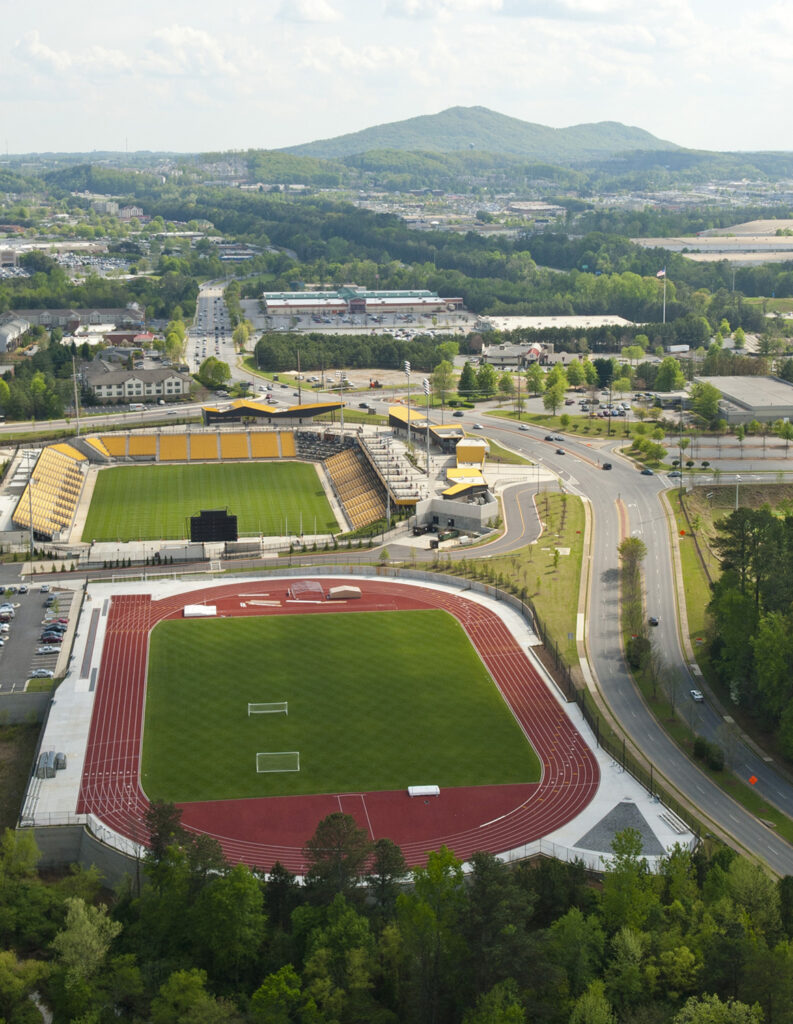
KSU’s efforts at internationalization and diversity occasionally generated controversy—most notably in the Jessica Colotl case, which received state and national attention. Colotl’s parents brought her from Mexico to Atlanta when she was a child. After graduating from a DeKalb County school, she enrolled at KSU in 2006. A minor campus traffic citation in 2010 led to the discovery that, although Colotl was not a U.S. citizen, she had been paying in-state tuition and was thereby being subsidized by Georgia taxpayers. That revelation ignited a protest against KSU and the USG, which had required undocumented immigrants to pay out-of-state tuition since 2007. In response, the Board of Regents issued a policy in 2010 prohibiting the enrollment of such students at any university that also turns away qualified applicants due to lack of space and requiring all institutions to verify that students paying in-state tuition are legal residents of Georgia. Colotl was ultimately allowed to stay in the country and graduate from KSU.
Athletic and Cultural Expansion
In 2010 KSU opened a state-of-the art stadium for its women’s soccer team. The university built the soccer stadium with the idea that it could also be used for football while a new program was being established. Papp selected Vince Dooley, the legendary University of Georgia coach and athletic director, to head a football exploratory committee. In September 2010 the committee issued a positive report. Two months later, a majority of KSU students voted in an online referendum to support a $100 increase in the athletic fee to support football and additional Title IX women’s sports. Papp, the Athletic Department, and the KSU Foundation began seeking private contributors, and in February 2013 the Board of Regents gave its approval to the football program and fee increase. KSU is scheduled to field its first team at Fifth Third Bank Stadium in fall 2015, playing at the NCAA’s Football Championship Subdivision level.
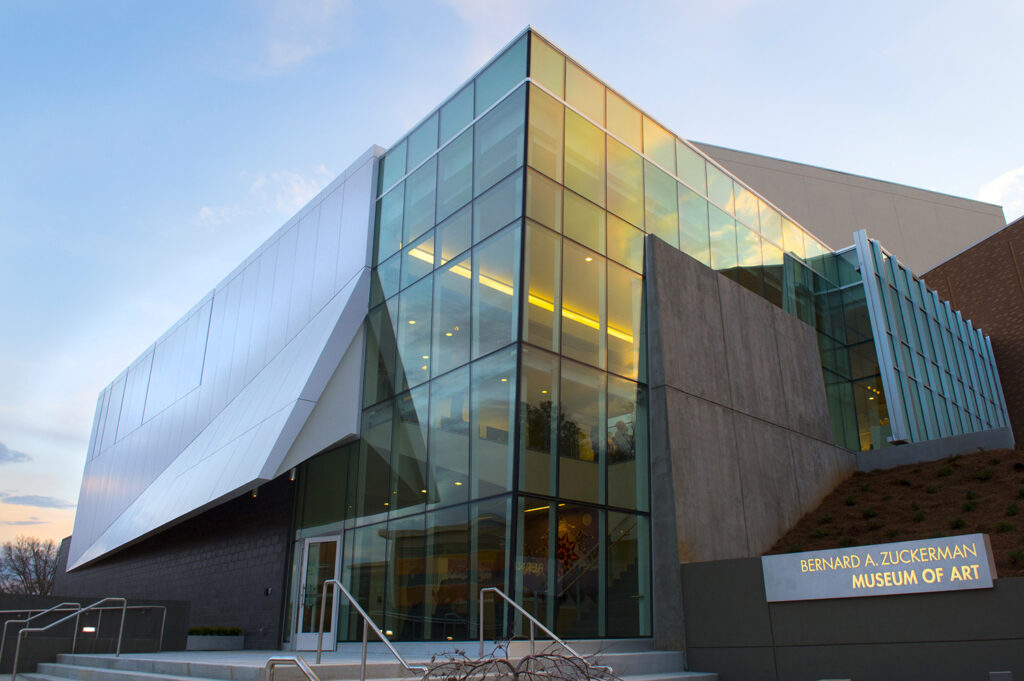
In March 2014 KSU opened the privately funded Bernard A. Zuckerman Museum of Art, which displays works from the university’s permanent art collection and galleries program. The museum also hosts exhibitions of contemporary works and student projects, and serves as a center for art education and professional development.
Comprehensive University Status and Consolidation
In August 2013 the Board of Regents reclassified KSU as a “comprehensive university” along with Georgia Southern University, the University of West Georgia, and Valdosta State University. The comprehensive universities offer numerous undergraduate and graduate programs, including some doctoral programs, and assume greater research expectations than other state colleges and universities.
In October 2013 KSU celebrated the fiftieth anniversary of its founding, and one month later the Board of Regents voted to consolidate KSU and Southern Polytechnic State University under the name of Kennesaw State University. USG chancellor Hank Huckaby appointed a consolidation implementation committee comprising an equal number of individuals from both campuses, and consolidation was complete by January 2015.
Papp resigned in June 2016 amid allegations of financial misconduct. Houston Davis served as interim president until the Board of Regents controversially appointed Sam Olens, the state’s attorney general, as president in October 2016. To some faculty, he seemed to be a purely political appointment. He lacked experience in higher education administration, and the USG did not conduct a national search for more qualified candidates, the standard method of hiring a new university president. Opposing student and alumni groups highlighted Olens’ history as attorney general which included his defense of Georgia’s ban on gay marriage, fearing that he would make the campus hostile to LGBTQ students. Despite faculty opposition and several student protests, he assumed the presidency on November 1, 2016. A 2017 USG report found that Olens and the university had not followed state policy on protests during the national anthem, which instructed universities to not interfere with nondisruptive demonstrations. In February 2018 Olens resigned and Ken Harmon was named interim president. The University System of Georgia declared that it would conduct a traditional national search for the next president.
In July 2018 Pamela Whitten assumed the presidency. Under her tenure, Kennesaw State University transitioned into the role of an R2 research university. She left the university in 2021 to become the president of Indiana University. Kathy Schwaig, who served as the interim president after Whitten’s departure, became the university president in March 2022.


